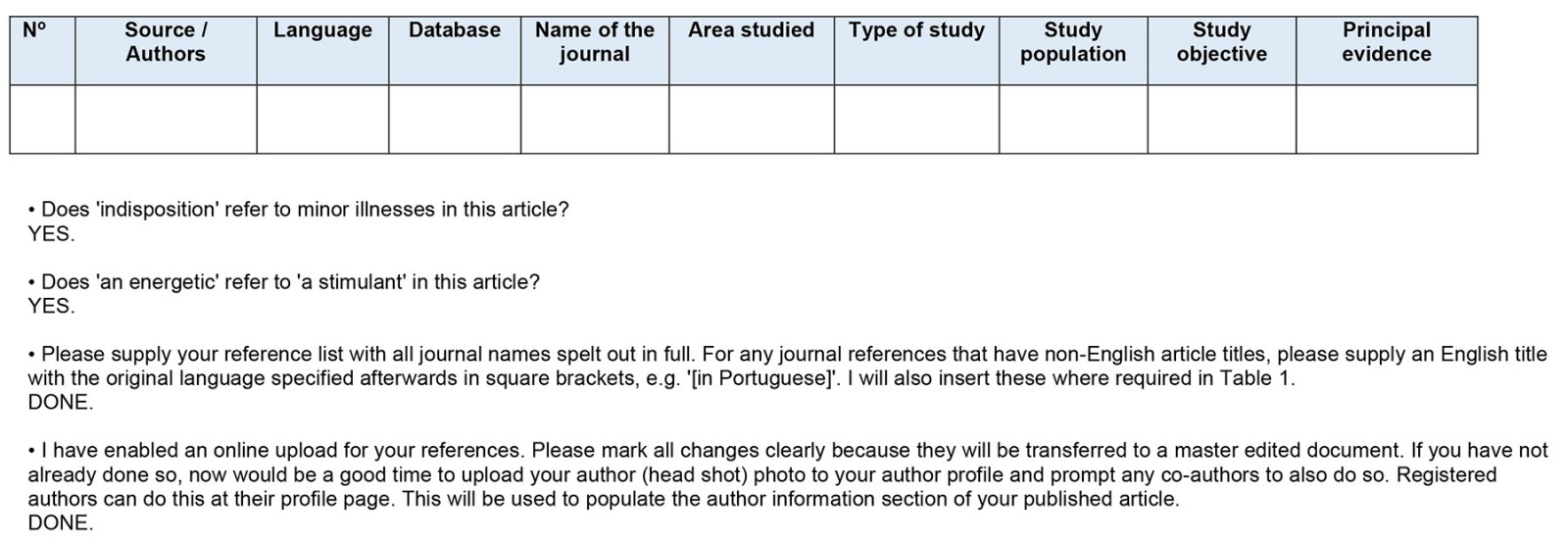Introduction
WHO defines traditional, complementary and integrative medicines as a broad set of healthcare practices based on theories and experiences from different cultures used for health promotion, prevention and recovery, taking into account the integral being in all its dimensions1,2. Traditional medicine has a long history of ancestry or tradition that is added to knowledge, capabilities and practices based on theories, beliefs and experiences of different cultures. These may or may not be explainable by current scientific methods, and can be used to maintain health and prevent, diagnose, improve or treat physical and mental diseases1,2. In this context, traditional medicine has been used by many different populations in the world3-7,and in Brazil in various situations in the treatment of physical and spiritual diseases8-10.
Brazil is a world reference in the field of traditional, complementary and integrative medicines, especially with regard to the insertion of these practices in the Unified Health System (Sistema Único de Saúde), which constitutes an important model of health care that in recent decades has been intensified through the National Policy of Integrative and Complementary Practices. This policy makes services in the branches of phytotherapy, homeopathy, traditional Chinese medicine/acupuncture and anthroposophical medicine available to the population11.
In the context of the Amazon, healing practices are common for solving physical, spiritual and magical-religious problems, using traditional medicine from natural resources, with emphasis on the use of medicinal plants in the form of teas, infusions, dressings, exudates, oils, incenses and smoke for rituals12, in addition to zootherapy13. Thus, ethnoknowledge and ethnomedicine have an important role among these peoples, who use them in the treatment of less complex diseases, such as fevers, diarrhea, emesis, headache, gastrointestinal disorders, insect bites, injuries, nausea and myalgia, and even diseases associated with cultural syndromes, such as the evil eye, spells and bad luck14,15.
‘Zootherapy’ is a polysemic term. In this study, its use concerns remedies made from parts of the bodies of animals, from products of their metabolism, such as body secretions and excrement, or from materials constructed with them, such as nests and cocoons, which are used in the treatment and prevention of diseases and disorders that affect humans16,17. The logistics and availability of resources influence the choice of zootherapy since there are animals that are close to homes, and that are domesticated, and others in the forest domains, which are wild. Thus, the production of home remedies is done using parts of the animals or from the whole animal – meat, fats, bones, eggs, livers, urine and extracted substrates, such as honey or wax – though animal fat is the most prevalent16.
Given the above, the mapping of the main practices of traditional medicine can contribute to the improvement of health care of traditional peoples and communities, and subsidize the practice of professionals who work mainly in the context of primary care and other levels of health care. It is worth remembering that, in this context, several health policies and organizational arrangements, such as the riverine and fluvial family health teams, have been implemented in the Unified Health System, and have aimed at reducing social inequalities in health and expanding these populations’ access to health care. Therefore, this study aimed to identify, map and synthesize scientific evidence on the use of traditional medicine as therapeutic resources when used by traditional communities of the Brazilian Amazon.
Methods
Concepts and definitions
In Brazil, traditional peoples and communities are recognized by the national policy of sustainable development of traditional peoples and communities, established by the Brazilian government’s decree 6040 of 7 February 200718. This decree recognizes them as culturally differentiated groups with their own forms of social organization, and that they occupy and use territories and natural resources as a condition for their social, cultural, religious, ancestral and economic reproduction19.
The Indigenous, riverine, quilombolas, caboclos, rubber tappers, fishers, farmers, extractivists and jute farmers, among others, are considered the traditional native populations of the Brazilian Amazon. These populations reside in rural areas, have contact with local natural resources and a vast knowledge regarding the cultivation and preservation of the flora and fauna of the environment, and this has been passed from generation to generation20,21.
The Brazilian Amazon is a large territorial extension and has an area of 5 217 423 km2, representing 61% of the national territory. It is a region with low demographic density, where more than 17 million people live, and covers, in its entirety, the states of Acre, Amapa, Amazonas, Mato Grosso, Pará, Roraima, Rondônia and Tocantins and, partially, the state of Maranhao (west of meridian 44º)22.
Type of study
This is a scoping review, which is a method used to map the main concepts of a research area, available evidence and its sources, and can be carried out using complex topics or areas that have not yet been reviewed. The value of a scoping review for evidence-based health and practice lies in examining a broader area to identify gaps in the research knowledge base, clarify key concepts and report on the types of evidence that address and inform practice in the field.
This scoping review was registered in the Open Science Framework platform (Open Science Framework; https://osf.io/453zw), and was developed based on the recommendations of the PRISMA-ScR International Guide23 and the method proposed by the Joanna Briggs Institute reviewers’ manual 202024, which uses five steps: (1) identification of the research issue; (2) identification of relevant studies; (3) selection of studies; (4) analysis of data; and (5) grouping, synthesis and presentation of data24.
For the construction of the research, we used the strategy of participants, concept and context (PCC), in which P is traditional populations; C is traditional medicine; and C is the Brazilian Amazon. Thus, the question of the research was ‘What is the main scientific evidence on the use of traditional medicine as a therapeutic resource among the traditional communities of the Brazilian Amazon?’
Data sources and research strategy
To obtain the scientific production on the use of traditional medicine as a therapeutic resource among the traditional communities of the Brazilian Amazon, the following five databases were used: PubMed/Medline, Lilacs, Scopus, Web of Science and ScienceDirect.
The search strategy in the databases used the following combination of MeSH controlled descriptors (medical subject headings) and DeCS (health sciences descriptors) in English and in Portuguese: Traditional Medicine, Medicina Tradicional; Traditional Communities, Comunidades Tradicionais; Brazil, Brasil.
Data collection
The database search took place between August and November 2022. The selection criteria were the following: scientific articles published in Portuguese or English, containing full texts and available in full, whose investigation made reference to the use of traditional medicine by traditional peoples and communities of the Brazilian Amazon. Abstracts and proceedings of congresses, comments, editorials, expert opinions, short communications and reports, theses and dissertations were excluded.
Data management
All scientific articles selected for the scoping review were imported into the Mendeley desktop bibliographic manager v1.19.8 (Mendeley; https://www.mendeley.com). Duplicate studies were removed manually when identified in the process of reading the abstracts. In the screening process, the scientific articles that met the scope of the research question were maintained in Mendeley for full reading and application of the instrument for extracting relevant information from each study.
Data analysis
The titles and abstracts of the articles retrieved in the search were read and analyzed by peers in order to identify those potentially eligible for the study. When there was no consensus among the reviewers, the article was kept in the database for the next phase, which involved the full reading of each selected article, and was evaluated by a third reviewer with the aim of confirming the main question of the research and, if positive, extracting the data of interest.
In the separation stage, the summary of the main scientific evidence was grouped into a structured instrument (Appendix I), as proposed by the Joanna Briggs Institute reviewers’ manual 202024.This instrument consists of the following items: title, authors, language, database, journal, place of study and publication, objective, type of study, population involved and the main scientific evidence of each study.
Therefore, the synthesis and presentation of the results took place with the intention of showing the general view of the practices of traditional medicine among the peoples and traditional communities of the Brazilian Amazon.
Results
The initial search in the five databases using the controlled descriptors of MeSH and DeCS, as well as their combinations, and totaled 1431 scientific articles. In the first screening, 207 studies were pre-selected; of these, 139 were excluded for not meeting the scope of the study, and another seven were excluded due to duplication. Therefore, the scoping review included 31 articles retrieved from the databases, which were distributed as follows: Lilacs 11 (36%), Pubmed/Medline 8 (26%), ScienceDirect 5 (16%), Scopus 5 (16%) and Web of Science 2 (6%). Among these articles, 22 (71%) were published in English and 9 (29%) were published in Portuguese (Fig1).
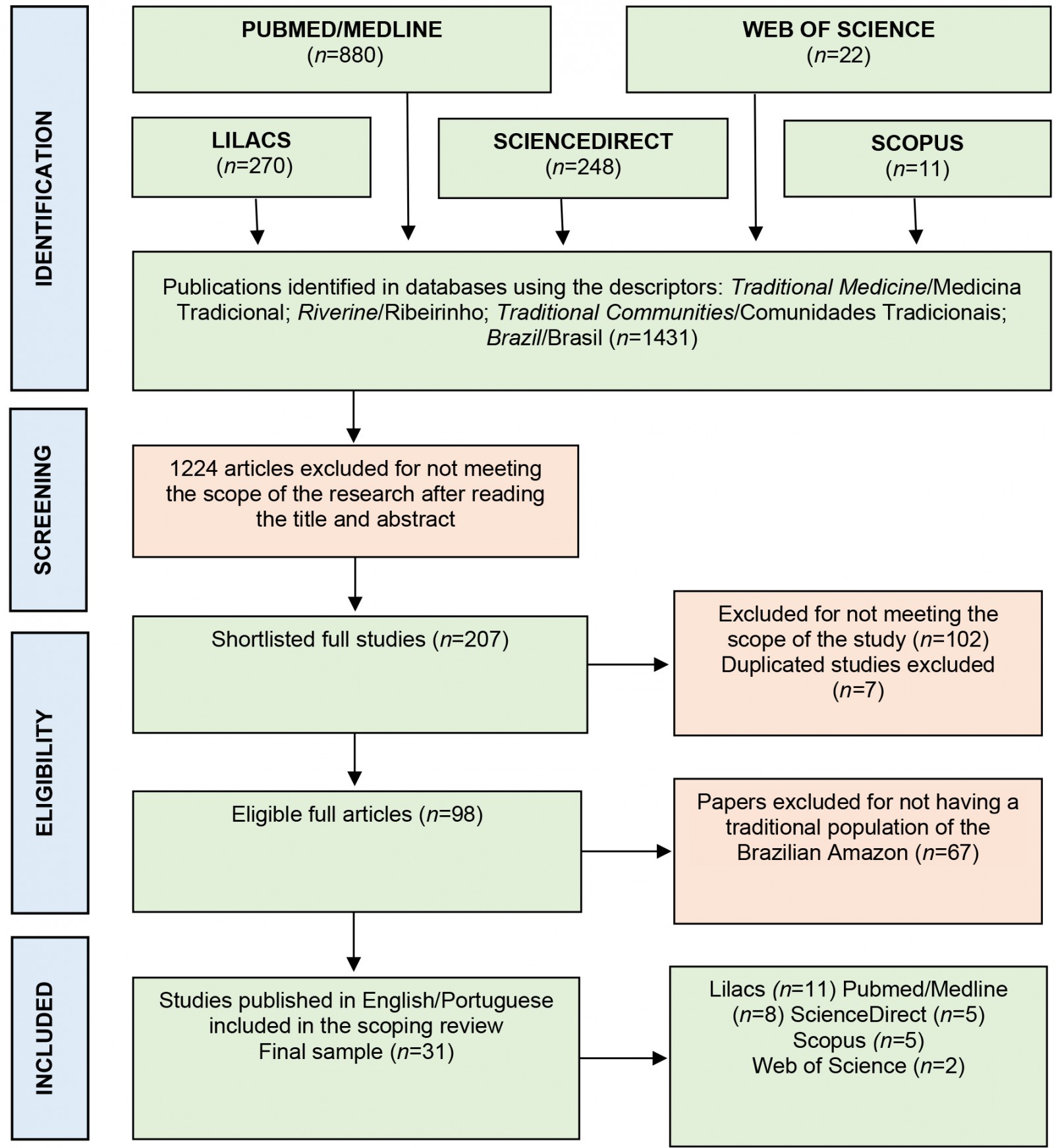 Figure 1: PRISMA-ScR23 flowchart used to operationalize the selection of articles regarding the use of traditional medicine as a therapeutic resource by traditional communities of the Brazilian Amazon.
Figure 1: PRISMA-ScR23 flowchart used to operationalize the selection of articles regarding the use of traditional medicine as a therapeutic resource by traditional communities of the Brazilian Amazon.
The studies conducted with traditional peoples and populations of the Brazilian Amazon occurred in six states: Para (11/36%), Amazonas (11/36%), Rondônia (3/10%), Acre (2/6%), Amapa (2/6%) and Mato Grosso (2/6%). Almost half of the studies (15/49%) were published in Brazilian scientific journals, and the rest were distributed among the following countries: Ireland (7/23%), Great Britain (6/19%), the United Arab Emirates (1/3%), Portugal (1/3%) and the US (1/3%).
Regarding the journals in which the scientific production on traditional medicine was published, 7 (23%) articles were published in the Journal of Ethnopharmacology, 4 (13%) in the Journal of Ethnobiology and Ethnomedicine, 2 (7%) in the Brazilian Journal of Medicinal Plants, 2 (7%) in the Brazilian Journal of Pharmacognosy, 2 (7%) in Acta Amazonica, among other national and international scientific journals (Fig2).
Regarding the types of studies adopted by the authors of the articles included in the scoping review, the classification was as follows: ethnobotanical studies (14/45%), ethnopharmacological (6/20%), ethnoecological (4/13%), among other associations of approaches and techniques of data collection (Table 1, Fig3).
Table 1: Synthesis of scientific publications on the use of traditional medicine as a therapeutic resource by traditional communities of the Brazilian Amazon25-52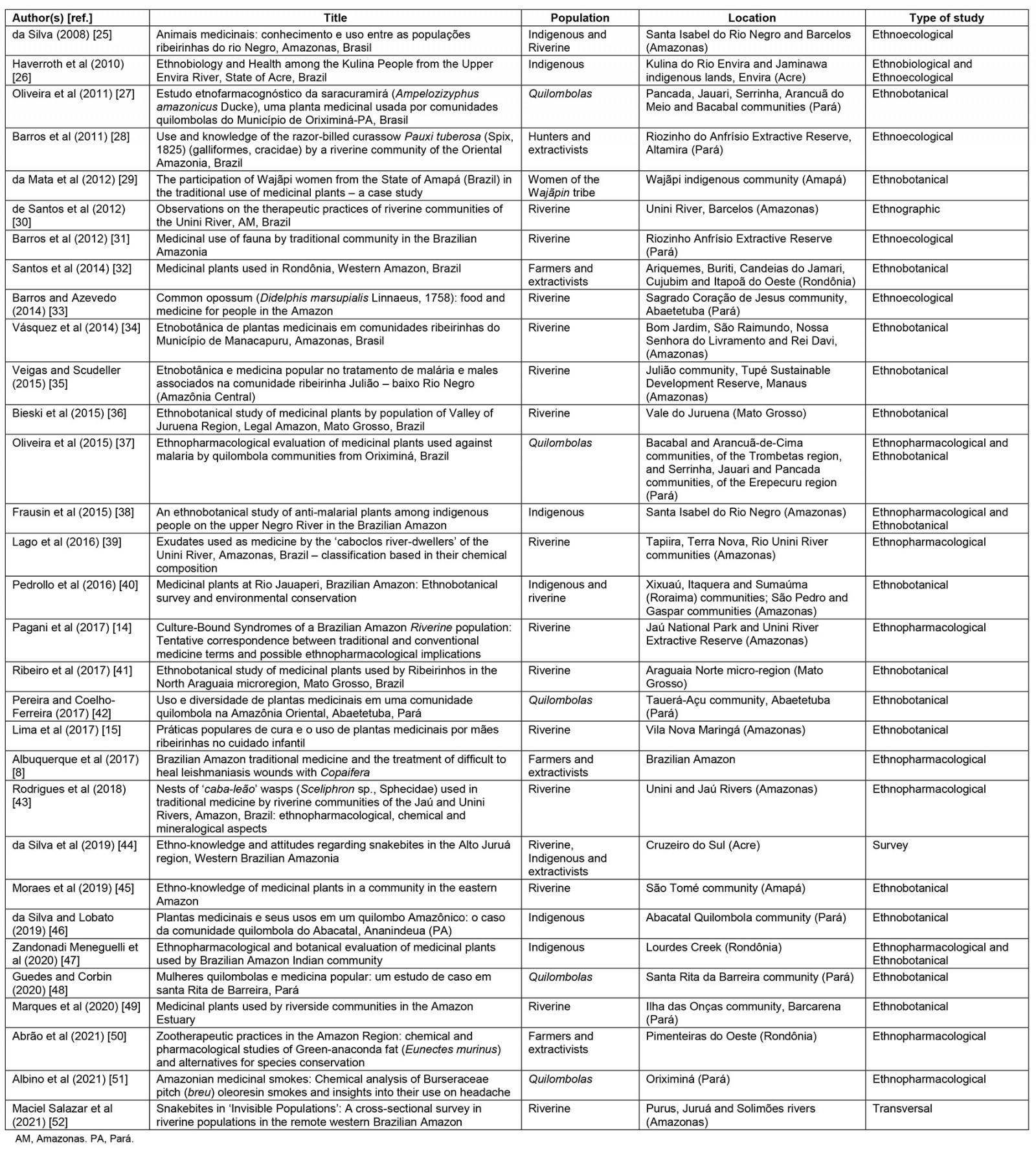
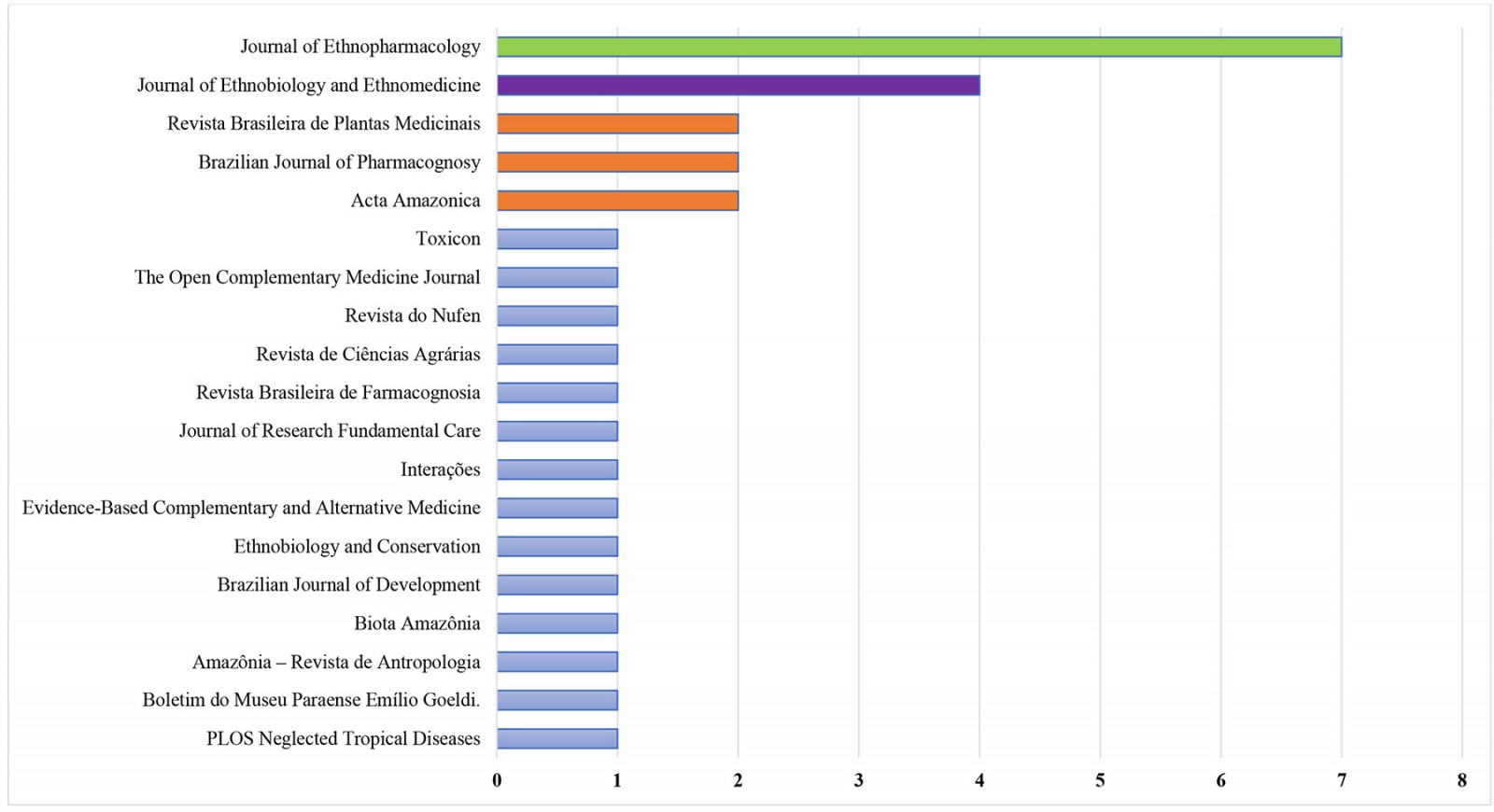 Figure 2: Journals with articles on the use of traditional medicine as a therapeutic resource utilized by traditional communities of the Brazilian Amazon.
Figure 2: Journals with articles on the use of traditional medicine as a therapeutic resource utilized by traditional communities of the Brazilian Amazon.
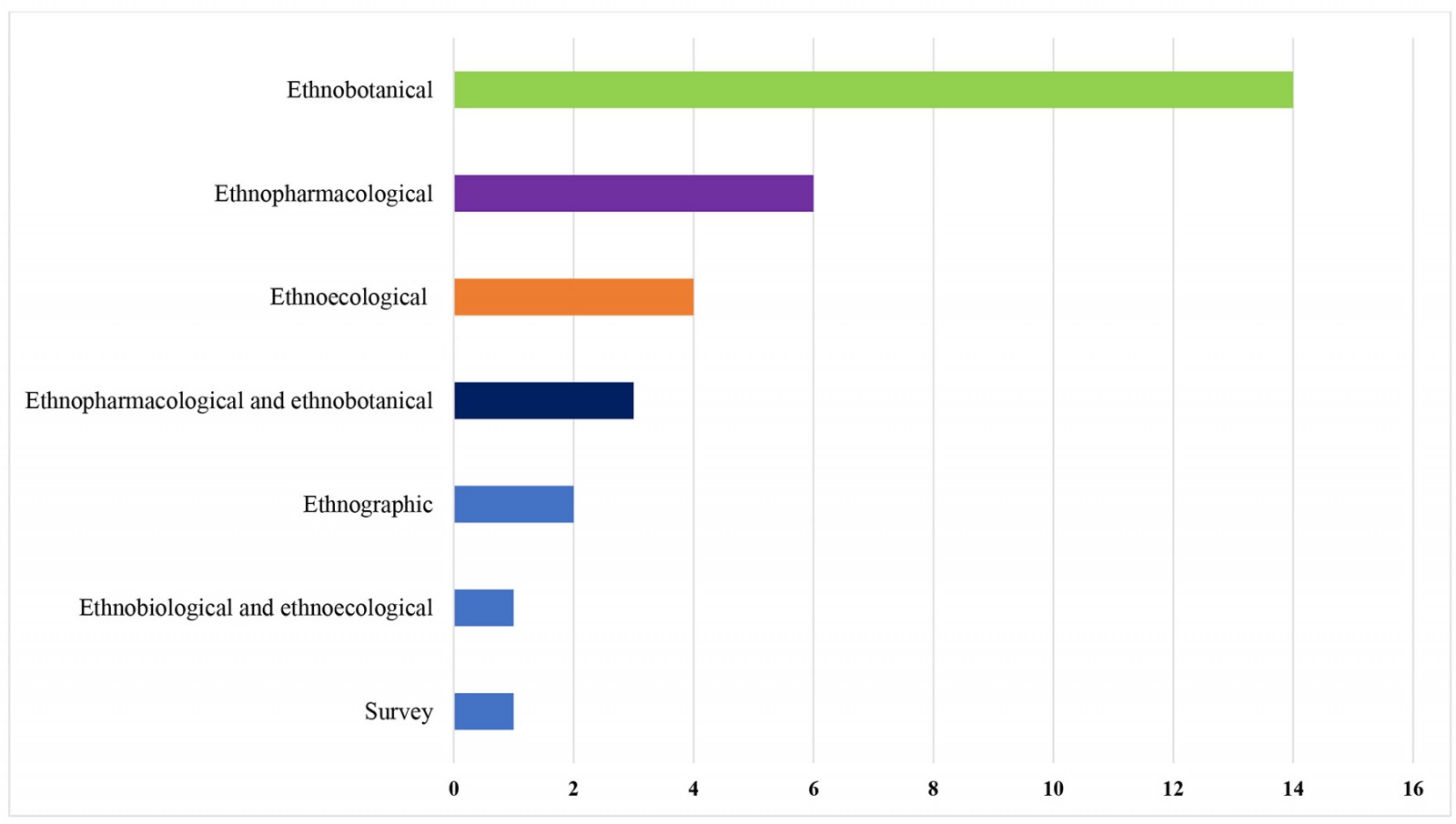 Figure 3: Types of scientific production on traditional medicines used as therapeutic resources in traditional populations in the Brazilian Amazon.
Figure 3: Types of scientific production on traditional medicines used as therapeutic resources in traditional populations in the Brazilian Amazon.
Regarding the culturally differentiated groups of the Brazilian Amazon in this study, the scoping review identified the following populations: riverine (14/45%); Indigenous (5/16%); quilombolas (5/16%); farmers and extractivists (3/10%); riverine and Indigenous (2/7%); hunters and extractivists (1/3%); and riverine, indigenous and extractivists (1/3%) (Table 1, Fig4).
In the present study, it was identified that medicinal plants are present in the vast majority of therapeutic practices used by traditional populations of the Brazilian Amazon, followed by vertebrate animals. In the category ‘medicinal products’, there are materials that do not fit the other three classifications; they are used for curative purposes in the form of tea made with shavings from the board of a pier or steps of a house, gunpowder tea, salt, sugar, limestone, gasoline and black stone (Fig5).
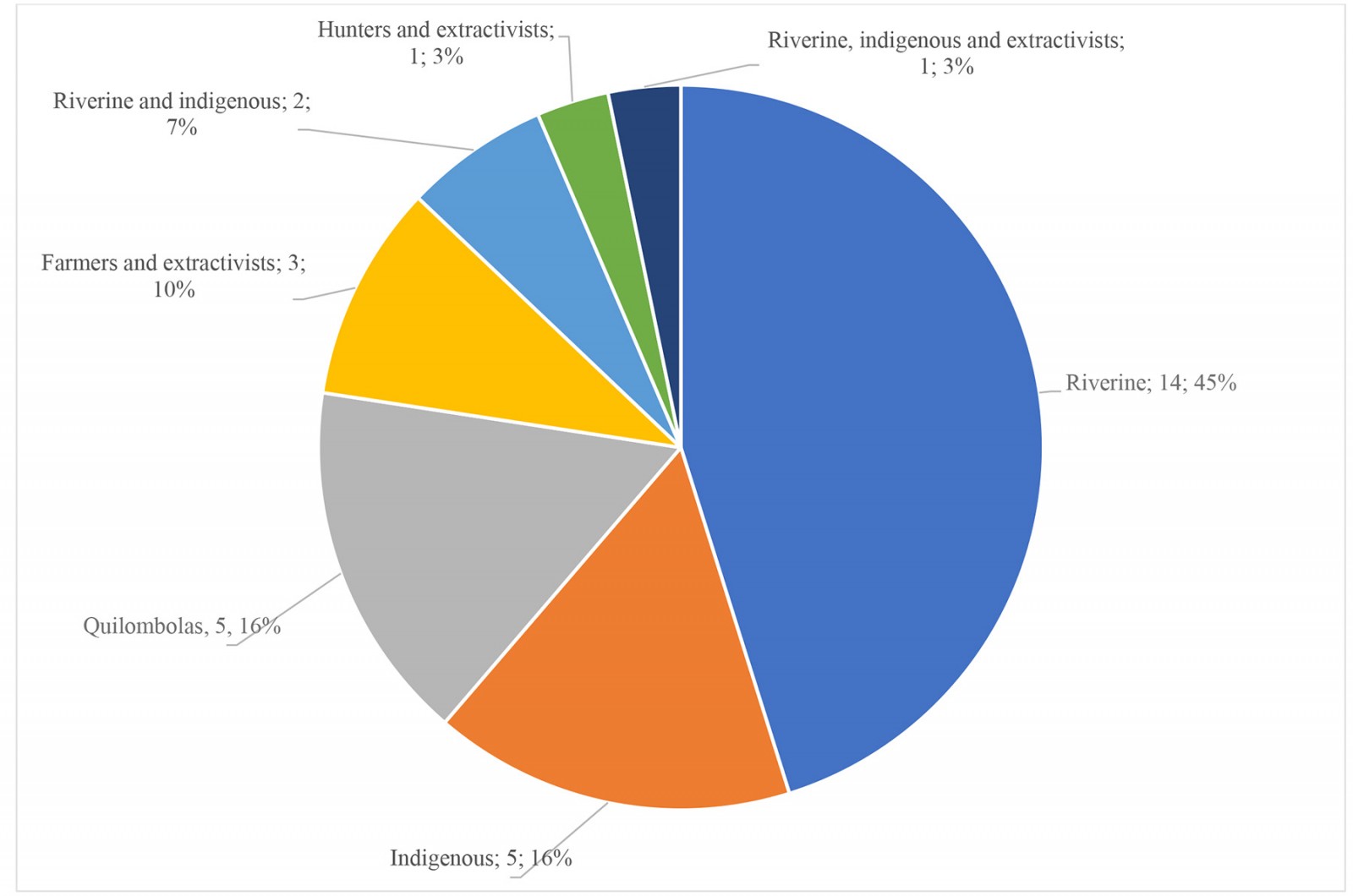 Figure 4: Traditional populations that participated in the studies included in the scoping review on the use of traditional medicine as a therapeutic resource by traditional communities of the Brazilian Amazon.
Figure 4: Traditional populations that participated in the studies included in the scoping review on the use of traditional medicine as a therapeutic resource by traditional communities of the Brazilian Amazon.
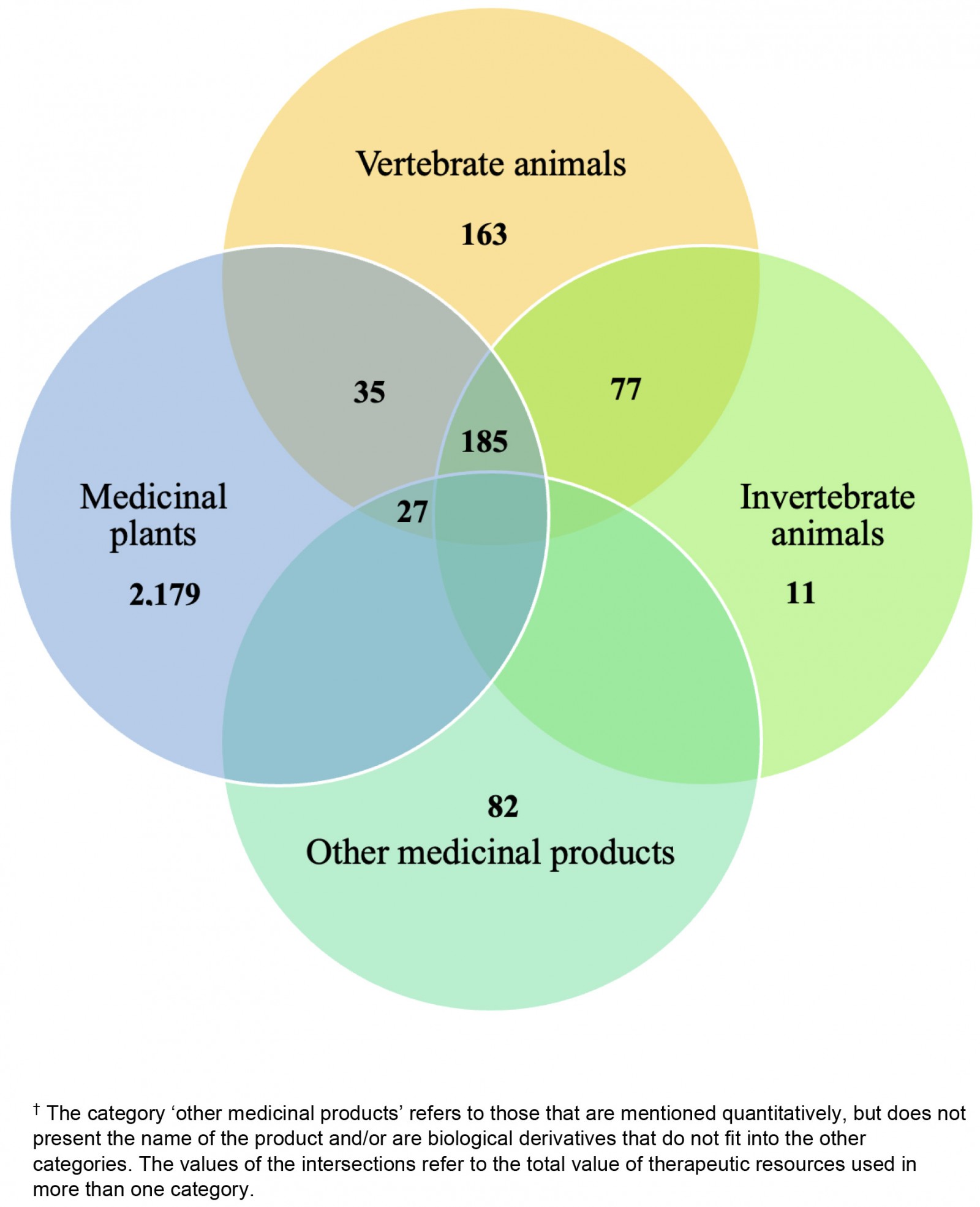 Figure 5: Venn diagram showing total number of therapeutic resources used for medicinal purposes classified into four categories.†
Figure 5: Venn diagram showing total number of therapeutic resources used for medicinal purposes classified into four categories.†
The following medicinal plants stood out for having wide consumption as therapeutic resources: mint (Mentha spp.), saracuramira (Ampelozizyphus amazonicus Ducke), arruda (Ruta graveolens), carapanauba (Apidosperma spp.), andiroba (Carapa guianensis), copaiba (Copaifera multijuga Hayne, Copaifera langsdorffi), açai (Euterpe oleracea, Euterpe precatoria), quebra-pedra (Phyllanthus niruri), paregoric elixir (Piper callosum) and lemongrass (Cymbopogon citratus). The use of the rosin from white pitch (Protium heptaphyllum) and black pitch (Trattinnickia burserifolia) is also a common practice among traditional populations of the Brazilian Amazon, especially in the form of smoke inhalation.
Among the parts of the plants used are the stem, bark, leaves, flowers, fruits, seeds, roots, tubers and whole plants. These are prepared in various manners, such as teas, infusions, smoke for rituals, baths, macerations, oils, ointments, concoctions, dressings, incense and exfoliants.
In this scoping review, the animals of great importance in traditional Amazonian medicine are mammals, reptiles and fish. In this context, we observed the use of these animals or part of them: green anacondas (Eunectes murinus), alligators (Paleosuchus sp.), white caimans (Caiman crocodilos), black caimans (Melanosuchus niger), stingrays (Potamotrygon sp.), capybaras (Hydrochoerus hydrochaeris), wolf fish (Hoplias malabaricus) and the razor-billed curassow (Pauxi tuberosa), among other animals. The main parts are lards, fats, visceras, horns, cocoons, nests, feathers and beaks of birds, eggs and roe.
Included in the diseases and disorders observed in the literature in which traditional populations resort to traditional medicine are malaria, respiratory diseases, strokes, rheumatism, asthma, diarrheal diseases and verminoses, leishmaniasis, snakebites, pneumonia, erectile dysfunction, ptiriasis versicolor, liver and gastrointestinal diseases, bruises, sprains and dislocations. Cultural syndromes are also highlighted, such as the evil eye, spells and bad luck (Table 2). Treatments for syndromes and other diseases in general are usually performed by or with the help of Amazonian healers, such as shamans, folk healers, midwives, mediums, faith healers and sorcerers.
Table 2: Descriptions of the main culture-bound syndromes that affect the traditional populations of the Brazilian Amazon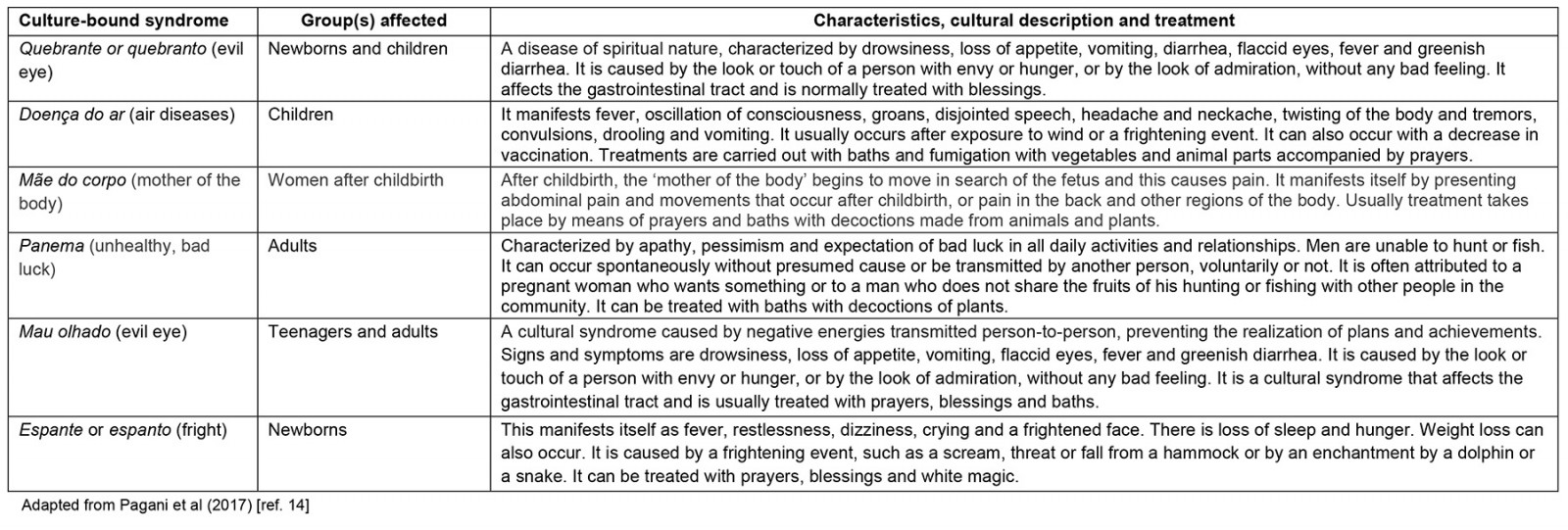
Discussion
The scientific production included in this scoping review (Fig2) draws attention to the fact that studies on traditional medicine in the Brazilian Amazon have a very heterogeneous distribution in journals in the areas of biological, health and social sciences, such as anthropology. In this context, it is important to look at this knowledge production in a positive way, considering that it is a transversal topic, of interest to different academic areas, where each one needs the other’s theoretical bases and techniques to better understand these practices as a relevant therapeutic resource, especially for health professionals who work with these populations53-55.
Among the traditional populations of the Brazilian Amazon, mint has been widely used for the treatment of colic, nausea and heartburn15,26,34,36,42. Other studies also show the use of mint for the same treatment purpose by populations from other regions of Brazil56,57.
Copaiba oil is an exudate extracted from copaiba trees, which has been used as a traditional medicine for more than 500 years. The use of copaiba oil is common in traditional populations as an anti-inflammatory and a healing agent, as well as in the treatment of hemorrhoids, respiratory diseases, insect bites, ulcers and lesions, especially in cases of leishmaniasis. In addition to numerous applications in cosmetics and other industries, there are a number of indications for its use in medicine58.
In some cases, copaiba oil has been proven to have antimicrobial, anti-inflammatory, and anti-neoplastic activity. Some studies have addressed the potential use of copaiba oil in dentistry, especially in the composition of endodontic cements and in the prevention and combat of periodontal disease59-61. A recently published study proved that, after three annual applications, copaiba-based varnish demonstrated significant antimicrobial activity against Streptococcus mutans for up to 12 months in children at high risk of caries. The fluoridated copaiba-based varnishes showed good results in the prevention of dental caries62.
Another exudate widely used in the Amazon is andiroba oil, which is widely used as an anti-inflammatory, especially in the treatment of otitis, muscle pain and throat problems, in addition to its use as a healing agent, antimalarial and a natural insect repellent29,37,48. Andiroba oil is recognized in traditional medicine and has anti-inflammatory and analgesic potential, both of which are basic prerequisites for a therapeutic agent. In this sense, the use of andiroba oil is able to reduce, for example, the severity of oral mucositis and relieve pain due to the disease, thus resulting in a decrease in the severity of signs and symptoms in dental patients63.
Saracuramira stands out for its potential use as an antimalarial, a depurative, a nerve tonic and in the treatment of liver diseases. Secondary use of this species also includes treatments for anemia, memory, stomach pain, diabetes mellitus, minor illnesses and malaria27,37,38,40.Studies also indicate the use of saracuramira as an aphrodisiac, a stimulant, and as an anti-inflammatory, in addition to being used as a treatment for tumors and other diseases64,65.Its antimicrobial action against isolated fungi has also been tested66.
In the Amazonian context, common rue (arruda) has been reported for the treatment of headaches, fevers, flu, diarrhea, viruses and parasites, among other uses15,27,37,42.It is a plant used in traditional medicine to minimize muscle pain, dermatitis, rheumatism and influenza symptoms, as it has antibacterial, anti-inflammatory, analgesic and antidiabetic properties67. This plant has remarkable biological activity and has become a medicinal plant in many countries, especially in the Mediterranean68.
Carapanauba is used as an anti-inflammatory, antimalarial and an analgesic, and is usually used in the treatment of diabetes mellitus and urinary tract infections27,37,38,40. In the Amazon, malaria is an endemic parasitic disease caused by organisms of the genus Plasmodium and the riverine communities of the municipalities of Pauini and Xapuri in the states of Amazonas and Acre, respectively, reported that carapanauba is one of the most used medicinal plants in the treatment of malaria69.
The açai berry, in addition to being an important source of energy in the diet of traditional populations, is also used in the treatment of malaria, hepatitis, anemias, gastrointestinal inflammations, snakebite, muscle pain and general inflammations15,35-37,44. Brazil is the largest producer of açai in the world and the foreign market has been investing in its importation for use both in the food and the pharmaceutical industries. Because it is a fruit that is rich in anthocyanins, which act by modulating lipid metabolism to minimize damage to the body caused by oxidative stress, triggered by chronic diseases, açai has been tested for the treatment of metabolic syndrome70. One systematic review pointed out that flavonoids present in acai have the potential for the treatment of diseases such as Parkinson’s disease and Alzheimer’s disease, and are now drug candidates in future clinical research. However, there is a need for in vitro and in vivo studies of polyphenols that prove and ratify the therapeutic potential of this fruit for these neurodegenerative diseases71.
The exudate of white pitch and black pitch has been reported to have been used for stroke, respiratory diseases and as an anti-inflammatory; its resin is often used for the treatment of headaches, inflammation and as an expectorant. Studies show that inhaling the smoke of white pitch and black pitch is effective for the relief of headaches. In this context, all the pitch oleoresins share the presence of volatile terpenoids and triterpenoids. These compounds are also present in crude resins and could potentially be responsible for the anti-inflammatory, antinociceptive and analgesic relief of headaches30,39,51. These Protium species (known as breus) produce a resin that is considered sacred to the Indigenous and riverine peoples, and is widely used by the Amazonian healers (shamans, folk healers, faith healers and sorcerers) in ceremonies and healing rituals to ward off evil spirits, and also in the treatment of physical problems of the populations of the entire Amazon. It can be used for the cure of headaches, as a nasal decongestant, to immobilize fractures and as a natural insect repellent72,73.
Quebra-pedra, or stonebreaker, can be used for the treatment of intestinal infections, kidney stones and renal colic, and has a secondary use for malaria and jaundice36,37. One study prospectively evaluated the effect of P. niruri on urinary metabolic parameters of patients with urolithiasis and revealed that ingestion is safe and does not cause significant adverse effects. It increases the urinary excretion of magnesium and potassium, thus causing a significant decrease in urinary oxalate and uric acid in patients with hyperoxaluria and hyperuricosuria, and contributes to the elimination of kidney stones74.
Paregoric elixir appears to treat gastrointestinal diseases, and lemongrass is also used to treat gastroentinal problems, in addition to respiratory problems. They can be used as antidepressants, since they are both used as tranquilizers15,34,37,48. In the Amazon region, paregoric elixir is sold fresh, dried, chopped and sometimes powdered or as an ingredient in artisanal preparations for medicinal purposes75. Lemongrass leaves are also sold at fairs and markets. Domestic cultivation is very common among traditional populations.
In addition to using medicinal plants, the practice of zootherapy as a therapeutic resource is common among traditional communities in the Amazon. In this study, we observed the use of the following animals or part of them: green anacondas, alligators, white caimans, black caimans, stingrays, capybaras, wolf fish and the razor-billed curassow (Pauxi tuberosa), among other animals14,25,28,31,33,43,44,50. In this context, animal fats and oils are used to treat muscle strains, bone dislocations, inflammatory processes, respiratory diseases, rheumatic diseases, in addition to helping wound healing.
In other situations, the white-lipped peccary (Tayassu pecari) can be used in the treatment of pneumonia, indigestion and asthma; the razor-billed curassowcan be used to treat bleeding, snakebite, indigestion and stroke; the armadillo (Priodontes maximus) can be used for treating snakebite, ear pain, asthma, colds and rheumatism; the tapir (Tapirus terrestres) can be used for indigestion, menstrual pain, hernia, sexual impotence, muscle pain, rheumatism and stroke28. Another animal study refers to the medicinal use of the opossum (Didelphis marsupialis) and consists of the extraction of its fat, since its oil has numerous therapeutic purposes consisting of anti-inflammatory treatments for rheumatism, bruises, asthma and sore throats. It is also recommended that pregnant women use opossum oil to diminish labor pains33.
One study analyzed the substances present in home remedies used by riverine communities in the Amazon that were the result of an insect, mineral and vegetable oil interaction. The results of the analyses showed that the main component was from the nests of black mud dauber wasps (Sceliphron sp.), which is used by riverine populations as a topical medicine in the treatment of mumps and ear pain. The inorganic components are formed by minerals (quartz, kaolinite, illite and gibbsite) that were identified by x-ray diffraction and infrared spectroscopy, and are common in the soil of the region. X-ray fluorescence analyses indicated that the most common oxides within the minerals are SiO2, Al2O3 and Fe2O343.
In the present study, cultural syndromes emerge, and are those associated with a specific symptomology of a certain population. In this context, one can find a certain cultural child or adult’s disease for which the treatment is performed by Amazonian healers, who are people who understand the healing process for this type of disease. Among them, spells, bad luck and the evil eye stand out. In these cases, treatments can be made based on medicinal plants, animal, blessings, consultations with mediums, baths, concoctions and others14,15. In this same perspective, another study with riverine populations in the region of the Middle Negro River (Amazonas, Brazil) showed the use of canuaru resin, which is an animal- and plant-based drug extracted from a species of frog known as the canuaru or Amazon milk frog (Phrynohyas resinifictrix) that is used to treat headaches via inhalation, and childhood diseases through fumigation76.
It is important to note that, in the Brazilian Amazon, therapeutic practices are often carried out with endogenous, wild and domesticated natural resources, which are present in the biodiverse environments of the traditional populations and involve magical-religious beliefs to treat all types of illnesses, including cultural syndromes that affect children, youths, adults and the elderly.
In addition, the interaction of traditional knowledge and biomedicine by traditional populations is common and has become a hybrid of popular knowledge and scientism during a treatment. However, these practices still need to be widely perceived and discussed by professionals from all health services, since they usually maintain a vertical relationship with patients, and the psychosocial and cultural determinants are of little interest for diagnosis and therapeutic conduct77.
Although the present study was geographically limited to the experiences of traditional peoples who inhabit the Brazilian Amazon, it is important to explain that these practices can be widely extended to several other peoples in South America, especially in those countries with a strong Indigenous presence in their demographic composition78-82, and also to other regions of the world83,84. These practices are influenced by local culture and vary according to the availability of natural resources in each territory, being passed on to future generations within the family and community.
Conclusion
This scoping review has an important role to disseminate and expand the discussion of traditional medicine practices, inviting readers, whether they are health professionals, community members, managers or decision-makers, to a continuing debate using an intercultural dialog necessary to improve approaches. interdisciplinary. From this perspective, it is essential to consider the comprehensive legal and legal framework that guides the public policies of national health systems.
In Brazil, the Unified Health Systemhas the National Policy of Integrative and Complementary Practices (Política Nacional de Práticas Integrativas e Complementares) that implements approaches in different government instances that seek qualified listening to popular knowledge with an expanded view of the health–disease–care process. In the Brazilian indigenous context, the National Health Care Policy for Indigenous Peoples includes a guideline to guarantee the articulation of traditional Indigenous health systems, from the perspective that all human societies have their own systems for interpreting, preventing and treating illnesses, which must be taken into consideration holistically.
Finally, it is important to reinforce that it is necessary that health professionals who work with traditional populations must seek at least an understanding of the other’s differences using the concept of otherness and interculturality to avoid a colonial imposition in daily practices during the provision of health care for these people.
Funding
This article was supported by Conselho Nacional de Desenvolvimento Científico e Tecnológico (CNPq productivity scholarship to W.M and J.S); was funded by Fundação de Amparo à Pesquisa do Estado do Amazonas (PRÓ-ESTADO, call No. 011/2021-PCGP/FAPEAM, call No. 010/2021-CT&I ÁREAS PRIORITÁRIAS and POSGRAD) and by the Ministry of Health, Brazil (proposal No. 733781/19-035).
Conflicts of interest
The authors declare no conflicts of interest for this study.
References
You might also be interested in:
2018 - Primary health care nurses' competencies in rural disasters caused by floods
2014 - Sudden collapses in the heat in patients on angiotensin type 2 receptor blockers




